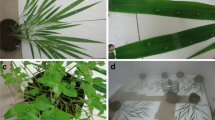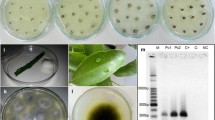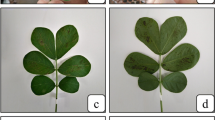Abstract
Citrus post-bloom fruit drop (PFD) is caused by Colletotrichum acutatum and C. gloeosporioides species complexes and frequently occurs in São Paulo (SP) state, Brazil. The environmental requirements for conidial germination and appressorium formation have been already determined in vitro; however, the environmental conditions for infection in citrus flowers remain unknown. C. acutatum is considered the main species complex causing PFD in citrus, but a survey of the pathogen’s prevalence has never been performed in SP state. The aims of this study were to assess the influence of different temperatures and wetness periods on infection of flowers by C. acutatum and C. gloeosporioides in potted citrus trees, and to determine the prevalence of both pathogens in different SP regions and sweet orange varieties. Environmental requirement trials were conducted in 2- to 3-year-old potted sweet orange trees. Flowers at different development stages (R2, R4 and R5) were inoculated with C. acutatum and C. gloeosporioides, and the trees were incubated at 18 or 24 °C for wetness periods of 6, 8, 12, 16 or 24 h. The percentages of inoculated flowers with PFD lesions and persistent calyces were calculated. The prevalence of both pathogens in SP regions was assessed in samples of diseased flowers collected at 16 commercial orchards of ‘Natal’, ‘Valencia’ and ‘Pera’ sweet oranges. The species complex was confirmed by isolation and PCR with species complex-specific primers. Blossom blight and persistent calyx incidences were higher in flowers inoculated with C. acutatum than in those inoculated with C. gloeosporioides. Incubation periods ranged from 2 to 5 days, and from 5 to 6 days for C. acutatum and C. gloeosporioides, respectively. In SP, irrespective of the region and sweet orange variety, C. acutatum was isolated from more than 80% of symptomatic flowers. We concluded that C. acutatum is not only more aggressive than C. gloeosporioides for causing PFD but also more prevalent in SP orchards.





Similar content being viewed by others
References
Agostini, J. P., & Timmer, L. W. (1994). Population dynamics and survival of strains of Colletotrichum gloeosporioides on citrus in Florida. Phytopathology, 84, 420–425.
Agostini, J. P., Timmer, L. W., & Mitchell, D. J. (1992). Morphological and pathological characteristics of strains of Colletotrichum gloeosporioides from citrus. Phytopathology, 82, 1377–1382.
Alvares, C. A., Stape, J. L., Sentelhas, P. C., de Moraes Gonçalves, J. L., & Sparovek, G. (2013). Köppen's climate classification map for Brazil. Meteorologische Zeitschrift, 22, 711–728.
Brown, A. E., Sreenivasaprasad, S., & Timmer, L. W. (1996). Molecular characterization of slow-growing orange and key lime anthracnose strains of Colletotrichum from citrus as C. acutatum. Phytopathology, 86, 523–527.
Campbell, C. L., & Madden, L. V. (1990). Introduction to plant disease epidemiology. New York: Wiley-Interscience.
Christiano, R. S. C., Dalla Pria, M., Jesus Junior, W., Amorim, L., & Bergamin Filho, A. (2009). Modelling the progress of Asiatic citrus canker on Tahiti lime in relation to temperature and leaf wetness. European Journal of Plant Pathology, 124, 1–7.
Ciampi-Guillardi, M., Baldauf, C., Souza, A. P., Silva Júnior, G. J., & Amorim, L. (2014). Recent introduction and recombination in Colletotrichum acutatum populations associated with citrus postbloom fruit drop epidemics in São Paulo, Brazil. Phytopathology, 104, 769–778.
Cordova, L. G., Madden, L. V., Amiri, A., Schnabel, G., & Peres, N. A. (2017). Meta-analysis of a web-based disease forecast system for control of anthracnose and botrytis fruit rots of strawberry in southeastern United States. Plant Disease, 101, 1910–1917.
Damm, U., Cannon, P. F., Woudenberg, J. H. C., & Crous, P. W. (2012). The Colletotrichum acutatum species complex. Studies in Mycology, 73, 37–113.
Fagan, H. J. (1979). Postbloom fruit drop, a new disease of citrus associated with a form of Colletotrichum gloeosporioides. Annals of Applied Biology, 91, 13–20.
Freeman, S., Katan, T., & Shabi, E. (1998). Characterization of Colletotrichum species responsible for anthracnose diseases of various fruits. Plant Disease, 82, 596–605.
Fundecitrus. (2020). Tree inventory of the São Paulo and West South-west Minas Gerais citrus belt: snapshot of groves in March 2020. Retrieved 02 November 2020 from https://www.fundecitrus.com.br/pdf/pes_relatorios/2020_06_25_Tree_Inventory_and_Orange_Crop_Forecast_2020-2021.pdf
Gilles, T., Fitt, B. D., Kennedy, R., Welham, S. J., & Jeger, M. J. (2000). Effects of temperature and wetness duration on conidial infection, latent period and asexual sporulation of Pyrenopeziza brassicae on leaves of oilseed rape. Plant Pathology, 49, 498–508.
Goes, A., Garrido, R. B. O., Reis, R. F., Baldassari, R. B., & Soares, M. A. (2008). Evaluation of fungicide applications to sweet orange at different flowering stages for control of postbloom fruit drop caused by Colletotrichum acutatum. Crop Protection, 27, 71–76.
Greer, L. A., Harper, J. D. I., Savocchia, S., Samuelian, S. K., & Steel, C. C. (2011). Ripe rot of south-eastern Australian wine grapes is caused by two species of Colletotrichum: C. acutatum and C. gloeosporioides with differences in infection and fungicide sensitivity. Australian Journal of Grape and Wine Research, 17, 123–128.
Howard, C. M., Maas, J. L., Chandler, C. K., & Albregts, E. E. (1992). Anthracnose of strawberry caused by the Colletotrichum complex in Florida. Plant Disease, 76, 976–981.
Huang, Y. J., Evans, N., Li, Z. Q., Eckert, M., Chèvre, A. M., Renard, M., & Fitt, B. D. (2006). Temperature and leaf wetness duration affect phenotypic expression of Rlm6-mediated resistance to Leptosphaeria maculans in Brassica napus. New Phytologist, 170, 129–141.
IBGE – Instituto Brasileiro de Geografia e Estatística. (2019). Levantamento Sistemático da Produção Agrícola. Retrieved 26 March 2019 from https://sidra.ibge.gov.br/tabela/1618#resultado
Kuramae-Izioka, E. (1997). A rapid, easy and high yield protocol for total genomic DNA isolation of Colletotrichum gloeosporioides and Fusarium oxysporum. Revista UNIMAR, 19, 683–689.
Lahey, K. A., Yuan, R., Burns, J. K., Ueng, P. P., Timmer, L. W., & Chung, K. R. (2004). Induction of phytohormones and differential gene expression in citrus flowers infected by the fungus Colletotrichum acutatum. Molecular Plant Microbe Interaction, 17, 1394–1401.
Li, W., Yuan, R., Burns, J. K., Timmer, L. W., & Chung, K. -R. (2003). Genes for hormone biosynthesis and regulation are highly expressed in citrus flowers infected with the fungus Colletotrichum acutatum, causal agent of postbloom fruit drop. Journal of American Society Horticultural Science, 128, 578–583.
Lima, W. G., Spósito, M. B., Amorim, L., Gonçalves, F. P., & Filho, P. A. M. (2011). Colletotrichum gloeosporioides, a new causal agent of citrus post-bloom fruit drop. European Journal of Plant Pathology, 131, 157–165.
Lin, Y., Stover, E., Sonoda, R., & Rosskopf, E. (2001). Stigma and style necrosis is associated with postbloom fruit drop disease in citrus following artificial inoculation. HortScience, 36, 1138.
Madden, L. V. & Ellis, M. A. (1988). How to Develop Plant Disease Forecasters. In: Kranz, J., Rotem, J. Experimental techniques in plant disease epidemiology. Springer-Verlag. pp. 191–206.
Madden, L. V., Hughes, G., & van den Bosch, F. (2007). The Study of Plant Disease Epidemics. St Paul, MN, USA: APS Press.
Marques, J. P. R., Amorim, L., Spósito, M. B., & Appezzato-da-Gloria, B. (2013). Histopathology of postbloom fruit drop caused by Colletotrichum acutatum in citrus flowers. European Journal o Plant Pathology, 135, 783–790.
McGovern, R. J., Sejio, T. E., Hendricks, K., & Roberts, P. D. (2012). New report of Colletotrichum gloeosporioides causing postbloom fruit drop on citrus in Bermuda. Canada Journal of Plant Patholology, 34, 187–194.
Mills, P. R., Hodson, A., & Brown, A. E. (1992). Molecular differentiation of Colletotrichum gloeosporioides isolates infecting tropical fruits. In J. A. Bailey & M. J. Jeger (Eds.), Colletotrichum: Biology, Pathology and Control. Wallingford: CAB Int. pp. 269–288.
Munir, M., Amsden, B., Dixon, E., Vaillancourt, L., & Gauthier, N. W. (2016). Characterization of Colletotrichum species causing bitter rot of apple in Kentucky orchards. Plant Disease, 100, 2194–2203.
Nunes, C. C., Alves, S. A., Bogo, A., Casa, R. T., Czermainski, A. B., & da Silva, F. N. (2016). Optimal conditions for conidial germination and infection of European pear leaves by Diplocarpon mespili. Tropical Plant Pathology, 41, 78–83.
Parlevliet, J. E. (1979). Components of resistance that reduce the rate of epidemic development. Annual Review of Phytopathology, 17, 203–222.
Peak, C. M., Fitzell, R. D., Hannah, R. S., & Batten, D. J. (1986). Development of a microprocessor-based data recording system for predicting plant disease based on studies on mango anthracnose. Computers and Electronics in Agriculture, 1, 251–262.
Peres, N. A. R., Souza, N. L., Furtado, E. L., & Timmer, L. W. (2004). Evaluation of systems for timing of fungicide sprays for control of postbloom fruit drop of citrus in Brazil. Plant Disease, 99, 731–735.
Peres, N. A., Timmer, L. W., Adaskaveg, J. E., & Correll, J. C. (2005). Lifestyles of Colletotrichum acutatum. Plant Disease, 89, 784–796.
Pertot, I., Caffi, T., Rossi, V., Mugnai, L., Hoffman, C., Grando, M. S., Gary, C., Lagond, D., Duso, C., Thiery, D., Mazzoni, V., & Anfora, G. (2017). A critical review of plant protection tools for reducing pesticide use on grapevine and new perspectives for the implementation of IPM in viticulture. Crop Protection, 97, 70–84.
Pinho, D. B., Lopes, U. P., Pereira, O. L., Silveira, A. L., & de Goes, A. (2015). Colletotrichum abscissum Pinho & OL Pereira, sp. nov. Persoonia, 34, 236–237.
Shi, Y., Correll, J. C., Guerber, J. C., & Rom, C. R. (1996). Frequency of Colletotrichum species causing bitter rot of apple in the southeastern United States. Plant Disease, 80, 692–696.
Silva Júnior, G. J., Spósito, M. B., Marin, D. R., & Amorim, L. (2014a). Efficacy and timing of application of fungicides for control of citrus postbloom fruit drop. Crop Protection, 59, 51–56.
Silva Júnior, G. J., Spósito, M. B., Marin, D. R., Ribeiro-Junior, P. J., & Amorim, L. (2014b). Spatiotemporal characterization of citrus postbloom fruit drop in Brazil and its relationship to pathogen dispersal. Plant Pathology, 63, 519–529.
Silva, A. O., Savi, D. C., Gomes, F. B., Gos, F. M. W. R., Silva Jr., G. J., & Glienke, C. (2017). Identification of Colletotrichum species associated with postbloom fruit drop in Brazil through GAPDH sequencing and multiplex PCR. European Journal of Plant Pathology, 147, 731–748.
Smith, B. J. (1995). Anthracnose fruit rot (black spot). In J. L. Maas (Ed.), Compendium of strawberry diseases (pp. 31–33). Saint Paul: APS Press.
Soares, A. R., Lourenço, S. A., & Amorim, L. (2008). Infecção de goiabas por Colletotrichum gloeosporioides e Colletotrichum acutatum sob diferentes temperaturas e períodos de molhamento. Tropical Plant Pathology, 3, 265–272.
Soares-Colletti, A. R., Alvares, C. A., & Sentelhas, P. C. (2016). An agro-climatic approach to determine citrus postbloom fruit drop risk in southern Brazil. International Journal of Biometeorology, 60, 891–905.
Sreenivasaprasad, S., & Talhinhas, P. (2005). Genotypic and phenotypic diversity in Colletotrichum acutatum a cosmopolitan pathogen causing anthracnose on a wide range of hosts. Molecular Plant Pathology, 6, 361–378.
Sreenivasaprasad, S., Sharada, K., Brown, A. E., & Mills, P. R. (1996). PCR-based detection of Colletotrichum acutatum on strawberry. Plant Pathology, 45, 650–655.
Talhinhas, P., Sreenivasaprasad, S., Neves-Martins, J., & Oliveira, H. (2005). Molecular and phenotypic analyses reveal association of diverse Colletotrichum acutatum groups and a low level of C. gloeosporioides with olive anthracnose. Applied and Environmental Microbiology, 71, 2987–2998.
Timmer, L. W., & Zitko, S. E. (1993). Relationships of environmental factors and inoculum levels to the incidence of postbloom fruit drop of citrus. Plant Disease, 77, 501–504.
Timmer, L. W., Agostini, J. P., Zitko, S. E., & Zulfiqar, M. (1994). Postbloom fruit drop, an increasingly prevalent disease of citrus in the America. Plant Disease, 78, 329–334.
Weir, B. S., Johnston, P. R., & Damm, U. (2012). The Colletotrichum gloeosporioides species complex. Studies in Mycology, 73, 115–180.
Zadoks, J. C. (1971). Systems analysis and the dynamics of epidemics. Phytopathology, 61, 600–610.
Zar, J. H. (1999). Biostatistical analysis. Uper Saddle River: Prentice-Hall.
Zulfiqar, M., Brlansky, R. H., Timmer, & L. W. (2018). Infection of flower and vegetative tissues of citrus by Colletotrichum acutatum and C. gloeosporioides. Mycologia, 88, 121–128.
Acknowledgements
We are grateful for financial support from the agencies FAPESP (2008/54176-4) and CNPq (authors scholarships) and Julio C. Rodrigues for the technical support.
Author information
Authors and Affiliations
Corresponding author
Ethics declarations
Human participants and animal studies
This research did not involve human participants or any animal experimentation.
Conflict of interest
The authors declare that they have no conflict of interest.
Rights and permissions
About this article
Cite this article
Gonçalves, F.P., Nogueira Júnior, A.F., Silva-Junior, G.J. et al. Environmental requirements for infection of Colletotrichum acutatum and C. gloeosporioides sensu lato in citrus flowers and prevalence of these pathogens in Brazil. Eur J Plant Pathol 160, 27–37 (2021). https://doi.org/10.1007/s10658-021-02218-7
Accepted:
Published:
Issue Date:
DOI: https://doi.org/10.1007/s10658-021-02218-7




